Services on Demand
Journal
Article
Indicators
Related links
Share
Revista Boliviana de Química
On-line version ISSN 0250-5460
Rev. Bol. Quim vol.30 no.1 La Paz 2013
Artículo
EAT-KAURANE DITERPENOIDS FROM BACCHARIS LEPTOPHYLLA
Lily Salcedo Ortiz1, Yonny Flores1, Olov Sterner2 y Giovanna R. Almanza Vega*1
Keywords: Baccharis leptophylla, Bolivian medicinal plañís, ent-kaurane diterpenoids, leptophyllin, ent-3![]() ,16
,16![]() ,19-trihydroxykaurane, ent-19-al-17,16
,19-trihydroxykaurane, ent-19-al-17,16![]() -dihydroxykaurane
-dihydroxykaurane
ABSTRACT
A known ent-kaurane diterpenoid, ewf-19-al-17,16P-dihydroxykaurane (1), together with the new one, ent-3![]() , 16
, 16![]() , 19-trihydroxykaurane (2), called leptophyllin, were isolated from aerial parts of Baccharis leptophylla. Their structures were established on the basis of NMR spectroscopic analysis. Based on this study the 1H and 13C NMR spectral data of compound (1) were completed by means of 2D NMR techniques.
, 19-trihydroxykaurane (2), called leptophyllin, were isolated from aerial parts of Baccharis leptophylla. Their structures were established on the basis of NMR spectroscopic analysis. Based on this study the 1H and 13C NMR spectral data of compound (1) were completed by means of 2D NMR techniques.
RESUMEN
Un diterpenoide conocido tipo ent-kaurano, ewf-19-al-17,16P-dihidroxikaurano (1), junto con un diterpenoide nuevo, ewf-3p,16p,19-trihidroxikaurano (2), llamado leptophyllin, fueron aislados de las partes aéreas de Baccharis leptophylla. Sus estructuras fueron establecidas en base a técnicas de análisis espectroscópico de RMN. En base a este estudio los datos de RMN XH y 13C del compuesto (1) fueron completados mediante técnicas de RMN 2D.
INTRODUCTION
Baccharis leptophylla is used by the "Alteño" Bolivian ethnia, against the backache, and is commonly known as "chiñi t'hola". This species was selected among 150 Bolivian plants, from the "Chacobo", "Moseten" and "Alteño" ethnias. The results of the primary pharmacological screening pointed out interesting antiparasitic activity against Leishmania amazonensis, L. brazüensis, L. donovani, Plasmodium falciparum (97% parasitemic inhibition at 100 ![]() g/ml in vitro) and P. vinckei (62% parasitemic inhibition at 1000 mg/kg/4J, in vivo). In addition, it has shown antibacterial activity against Staphylococcus aureus and Bacillus subtilis at a concentration of 1 mg/ml [1]. Continuing our chemical investigations of the Bolivian Baccharis [2-4], we have studied the dichloromethane extract of Baccharis leptophylla, a Bolivian plant belongs of the large genus Baccharis (Compositae, tribe Asteraceae). This genus has a big representation in the Bolivian biodiversity [5,6] and its chemistry is not very uniform, the most widespread compounds are flavonoids [2-4,7] and diterpenoids type clerodane [6,7], but labdane and kauranes have also been isolated [5,7,8]. Here we report the isolation and structure elucidation of two ent-kaurane diterpenoids, a new one ent-3
g/ml in vitro) and P. vinckei (62% parasitemic inhibition at 1000 mg/kg/4J, in vivo). In addition, it has shown antibacterial activity against Staphylococcus aureus and Bacillus subtilis at a concentration of 1 mg/ml [1]. Continuing our chemical investigations of the Bolivian Baccharis [2-4], we have studied the dichloromethane extract of Baccharis leptophylla, a Bolivian plant belongs of the large genus Baccharis (Compositae, tribe Asteraceae). This genus has a big representation in the Bolivian biodiversity [5,6] and its chemistry is not very uniform, the most widespread compounds are flavonoids [2-4,7] and diterpenoids type clerodane [6,7], but labdane and kauranes have also been isolated [5,7,8]. Here we report the isolation and structure elucidation of two ent-kaurane diterpenoids, a new one ent-3![]() ,16
,16![]() , 19-trihydroxykaurane 1 and a known one ent-19 aldehyde-17,16P-dihydroxykaurane 2, isolated of dichloromethane extract from Baccharis leptophylla aerial parts. The kaurane diterpenoids are a very interesting group of tetracyclic diterpenes constituted by a perhydrophenantrene unit (A, B and C rings) fused with a cyclopentane unit (D-ring) formed by a bridge between C-8 and C-13. They belong from several families such as Asteraceae (Baccharis), Annonnaceae, Euphorbiaceae, Celastraceae, Lamiaceae, Erythroxylaceae and Rhyzophoraceae [9] and several showed interesting biological and pharmacological properties. In particular, it is interesting that 16
, 19-trihydroxykaurane 1 and a known one ent-19 aldehyde-17,16P-dihydroxykaurane 2, isolated of dichloromethane extract from Baccharis leptophylla aerial parts. The kaurane diterpenoids are a very interesting group of tetracyclic diterpenes constituted by a perhydrophenantrene unit (A, B and C rings) fused with a cyclopentane unit (D-ring) formed by a bridge between C-8 and C-13. They belong from several families such as Asteraceae (Baccharis), Annonnaceae, Euphorbiaceae, Celastraceae, Lamiaceae, Erythroxylaceae and Rhyzophoraceae [9] and several showed interesting biological and pharmacological properties. In particular, it is interesting that 16![]() ,17-dihydroxy-ent-kauran-19-oic acid showed significant activity against HIV replication in H9 lymphocyte cells with an EC50 valué of 0.8 ug/mL [10] and 16
,17-dihydroxy-ent-kauran-19-oic acid showed significant activity against HIV replication in H9 lymphocyte cells with an EC50 valué of 0.8 ug/mL [10] and 16![]() -hydro-19-al-ewf-kauran-17-oic acid showed complete inhibitory effects on rabbit platelet aggregation at 200
-hydro-19-al-ewf-kauran-17-oic acid showed complete inhibitory effects on rabbit platelet aggregation at 200 ![]() M [11] because they have very cióse structures to compound 1. So, it should show similar properties or should be used as a precursor of them.
M [11] because they have very cióse structures to compound 1. So, it should show similar properties or should be used as a precursor of them.
RESULTS AND DISCUSSION
Compound 1 was obtained as white crystals (m.p. 182-183°C), its EIMS showed the molecular peak at m/z 320 and the 13C NMR spectrum (Table 1) displayed 20 carbón signáis corresponding to four quaternary carbons, four methines, ten methylenes and two methyls, suggesting a diterpenoid skeleton with an elemental composition C20H34O3. Complete structure elucidation of 1 resulted from interpretation of its NMR data. Analyzing the 13C data we can distinguish three signáis, a signal at ![]() 206.0 assigned to CHO at C-19, a quaternary carbón linked to oxygen at 5 81.8 assigned to C-16 and a methylene carbón, also join to oxygen, at 5 66.3 assigned to C-17. The diagnostic of the rest of the signáis showed three methines at
206.0 assigned to CHO at C-19, a quaternary carbón linked to oxygen at 5 81.8 assigned to C-16 and a methylene carbón, also join to oxygen, at 5 66.3 assigned to C-17. The diagnostic of the rest of the signáis showed three methines at ![]() 56.5 (C-5), 55.3 (C-9) and 45.3 (C-13) and three quaternary carbons more at
56.5 (C-5), 55.3 (C-9) and 45.3 (C-13) and three quaternary carbons more at ![]() 48.4 (C-4), 44.5 (C-8) and 39.4 (C-10) indicating an ent-kaurene skeleton for the diterpenoid. The COSY spectrum showed the presence of three protón sequences of -CH2 (1)-CH2 (2)-CH2 (3)-, -CH (5)-CH2 (6)-CH2 (7) -and -CH (9)-CH2 (11)-CH2 (12)-CH (13)-CH2 (14)-, as shown in the table 2. An oxygenated methylene (5H 3.79 and 3.67, each 1H, d, 7=11 Hz, 5C 66.3), which correlates with the protons H-15 (Table 2), was confirmed in C-17, and a methine CHO (5H 9.74 s, 1H; 5C 206.0) was located in C-19 based on the HMBC correlations of H-19 with C-4 and C-3. Finally, the long distance correlations from H-17 and H-15 methylene protons with C-16 confirm the location of the last oxygenated substitution in the quaternary carbón (Figure 2).
48.4 (C-4), 44.5 (C-8) and 39.4 (C-10) indicating an ent-kaurene skeleton for the diterpenoid. The COSY spectrum showed the presence of three protón sequences of -CH2 (1)-CH2 (2)-CH2 (3)-, -CH (5)-CH2 (6)-CH2 (7) -and -CH (9)-CH2 (11)-CH2 (12)-CH (13)-CH2 (14)-, as shown in the table 2. An oxygenated methylene (5H 3.79 and 3.67, each 1H, d, 7=11 Hz, 5C 66.3), which correlates with the protons H-15 (Table 2), was confirmed in C-17, and a methine CHO (5H 9.74 s, 1H; 5C 206.0) was located in C-19 based on the HMBC correlations of H-19 with C-4 and C-3. Finally, the long distance correlations from H-17 and H-15 methylene protons with C-16 confirm the location of the last oxygenated substitution in the quaternary carbón (Figure 2).

Figure 1. Structures of diterpenoids 1 and 2
Table 2. 1H NMR, COSY and NOESY data for compound 1
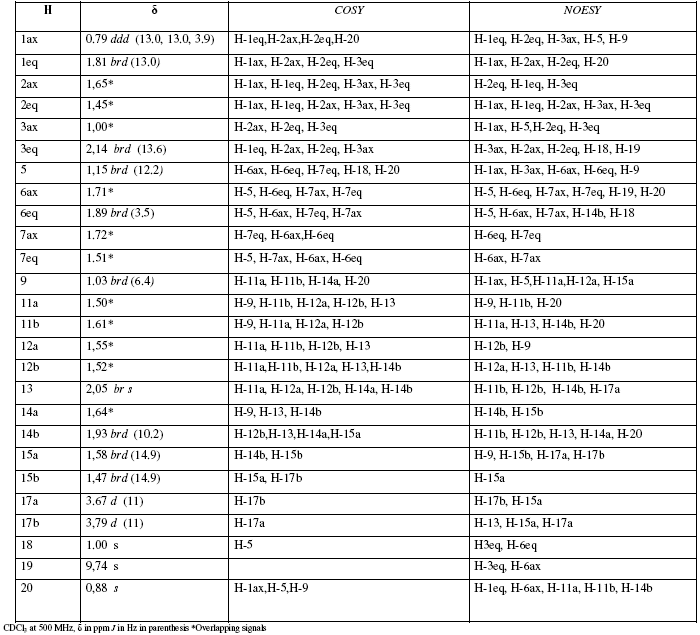
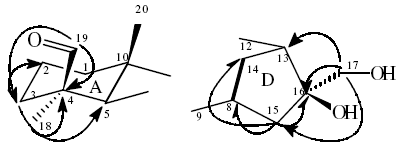
Figure 2. Some HMBC correlations for compound 1
The relative configuration of 1 was established mainly based on NOE effects observed in the NOESY spectrum, where we can observe the follow important NOE correlations: i) H-lax with H-3ax, H-5 and H-9 showing the binding of the rings A and B in trans; ii) The correlation of H-20 with H-leq, H-6ax, H-l la, H-l Ib and H-14b as well as of H-9 with H-lax, H-5, H-12a and H-15a showing the binding cis of the rings B and C and the relative positions of the rings; iii) finally the coupling of H-15a with the protons H-17 as well as of H-13 with H-17b confirmed the proposed position of the hydroxylated methylene group (Figure 3). Compound 1 was previously reported [12], comparing the 13C NMR data with those reported we found small differences attributed mainly to the change of solvent. In relation of 1H NMR data, in the previous paper not all the protons were assigned neither its relative configuration. Then with this work we give a contribution for the characterization of compound 1.
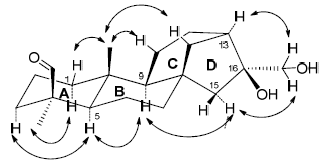
Figure 3. Some NOE correlations to assign the relative configuration of compound 1
Compound 2 also showed the characteristic signáis for an ewf-kaurane diterpenoid. So, its EIMS showed the molecular peak at m/z 322 corresponding to C20H34O3 and its 13C NMR spectrum (Table 1) displayed 20 carbons corresponding to four quaternary carbons, four methines, nine methylenes and three methyls, among them the signáis at ![]() 80.2 (CH), 78.8 (C) and 64.0 (CH2) suggest three oxygenated substitutions in the skeleton. Complete structure elucidation of 2 resulted from interpretation of its ID and 2D NMR data. The COS Y spectrum showed an oxygenated methylene (
80.2 (CH), 78.8 (C) and 64.0 (CH2) suggest three oxygenated substitutions in the skeleton. Complete structure elucidation of 2 resulted from interpretation of its ID and 2D NMR data. The COS Y spectrum showed an oxygenated methylene (![]() H 3.19 and 4.08, each 1H, d, J=11 Hz,
H 3.19 and 4.08, each 1H, d, J=11 Hz, ![]() C 64.0) assigned to C-19, because H-19a correlates to long distance W with H-3and H-5. On the other side the oxygenated methine was assigned to C-3 because the double doublet at
C 64.0) assigned to C-19, because H-19a correlates to long distance W with H-3and H-5. On the other side the oxygenated methine was assigned to C-3 because the double doublet at ![]() H 3.25 (J= 11 and 5 Hz) showed correlations with the protons H-2 and those with methylene protons H-1 (Table 3). Finally the last oxygenated substitution was located at C-16 based on the HMBC correlations of the H-15 and H-17 protons with the quaternary carbón at
H 3.25 (J= 11 and 5 Hz) showed correlations with the protons H-2 and those with methylene protons H-1 (Table 3). Finally the last oxygenated substitution was located at C-16 based on the HMBC correlations of the H-15 and H-17 protons with the quaternary carbón at ![]() 78.8 assigned to C-16. The figure 4 shows these and other important long heteronuclear correlations for compound 2.
78.8 assigned to C-16. The figure 4 shows these and other important long heteronuclear correlations for compound 2.
Table 1. 13C NMR data to compounds 1 and 2
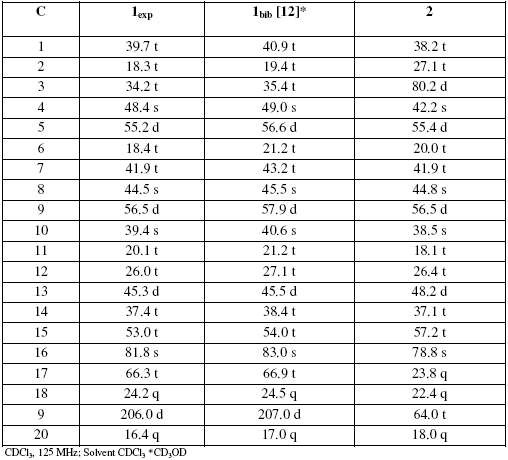
Table 3. 1HNMR, COSY and NOESY data for compound 2
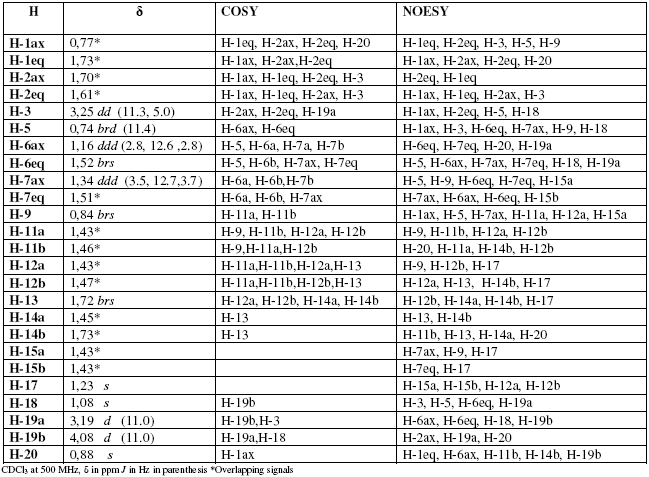

Figure 4. Some HMBC correlations for compound 2
The relative configuration of 2 was also established mainly through the analysis of NOESY spectrum where we can see the follow relevant correlations: i) H-5 correlates with H-lax, H-3, H-7ax, H-18 and H-9 showing the binding of the rings A and B in trans and suggesting the location of the oxygenated substitutions in C-3 and C-19 in the other side of the molecule; ii) H-20 correlates with H-1eq, H-6ax, H-11b, H-14b and H-19b determining the binding cis of the rings B and C and confirming the relative position of the CH2OH-19; iii) finally H-15a correlates with H-7ax, H-9 and H-17 giving the relative configuration of C-16 and determining the ![]() -position of OH in C-16.
-position of OH in C-16.
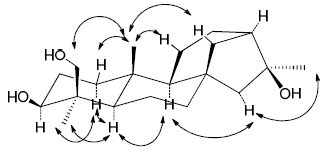
Figure 5. Some NOE correlations to assign the relative configuration of compound 2
Compound 2 is reported here for first time contributing to the study of Baccharis sp in particular of the medicinal Baccharis from Bolivia.
EXPERIMENTAL
General
Mp: uncorr; EIMS were obtained by direct inlet 70 eV. 1H and 13C-NMR were recorder at 500 MHz using TMS and CDC13 residual signáis as references; chemical shift valúes are reported in ![]() (ppm) units and coupling constants (J) in Hz. Silica gel (E.M. Merck, 70-230 mesh) and silica gel G-60 (E.M. Merck) were used for CC and VLC, respectively, while aluminum plates impregnated with silica gel 60 F254 (E.M. Merck) were used for analytical (0.25 mm) and preparative (1 mm) TLC analyses. Spots on chromatograms were detected under UV light (254 and 365 nm) and by spraying the plates with 10% H2SO4, followed by heating.
(ppm) units and coupling constants (J) in Hz. Silica gel (E.M. Merck, 70-230 mesh) and silica gel G-60 (E.M. Merck) were used for CC and VLC, respectively, while aluminum plates impregnated with silica gel 60 F254 (E.M. Merck) were used for analytical (0.25 mm) and preparative (1 mm) TLC analyses. Spots on chromatograms were detected under UV light (254 and 365 nm) and by spraying the plates with 10% H2SO4, followed by heating.
Plant material
The aerial parts of B. leptophylla (Asteraceae) were collected at Mizque province (Cochabamba, Bolivia) in September 2006 and identified by Lia de Michel, a botanist of the National Herbarium of Bolivia where a voucher specimen was deposited.
Extraction and isolation
The dry and ground plant material (1900 g) was first extracted with petroleum ether for 10 min at room temperature, the solution was filtered off and evaporated to yield the petroleum ether extract (8 g). The solid residue was macerated for 2 hours with CH2CI2, which after filtering and evaporation of the solvent gave the CH2CI2 extract (48g). Finally, the residue was extracted with EtOH for 48 hours; the ethanolic extract was partitioned between CH2C12 and H2O to give a CH2Cl2/EtOH crude fraction (12 g). The two extracts and the crude fraction were analyzed by TLC showing the last fraction the most interesting and less complex composition being selected for this study.
The CH2Cl2/Et0H crude fraction (12 g) was subjected to VLC on silica gel, eluting with increasing amounts of CH2C12 in petroleum ether, followed by increased amounts of MeOH in CH2CI2 finalizing with MeOH, to give nine main fractions. Fractions 2, 5 and 6 were submitted to repeated column chromatography led, after purification by recrystallization in MeOH, the ent-kaurane diterpenoids 1 (42 mg) and 2 (28 mg) isolated together with the oleanolic acid (7 mg) and the flavonoid 3,5,7-trihydroxy-4'-methoxyflavanone (10 mg) previously reported in the same species.
Compound 1 (ent-19-al-17,16![]() -dihydroxykaurane)
-dihydroxykaurane)
Compound obtained as white crystals (mp. 182-183 °C ) and identified as ent-19-al-17,16![]() -dihydroxykaurane based mainly in the NMR ID and 2D spectra. 1H NMR, 1H-1H-COSY and HMBC data see Table 3, 13C NMR data see Table 2. MS [M]+ peak at m/z 322 corresponding to C20H34O3
-dihydroxykaurane based mainly in the NMR ID and 2D spectra. 1H NMR, 1H-1H-COSY and HMBC data see Table 3, 13C NMR data see Table 2. MS [M]+ peak at m/z 322 corresponding to C20H34O3
Compound 2 (ent-3![]() ,16
,16![]() ,19-trihydroxykaurane)
,19-trihydroxykaurane)
Diterpene obtained as white crystals and identified as ent-3![]() ,16
,16![]() ,19-trihydroxykaurane based mainly in the NMR ID and 2D spectra. 1H NMR, 1H-1H-COSY and HMBC data see Table 1, 13C NMR data see Table 2. MS [M]+ peak at m/z 322 corresponding to C20H34O3.
,19-trihydroxykaurane based mainly in the NMR ID and 2D spectra. 1H NMR, 1H-1H-COSY and HMBC data see Table 1, 13C NMR data see Table 2. MS [M]+ peak at m/z 322 corresponding to C20H34O3.
ACKNOWLEDGEMENTS
The authors are grateful to the Swedish Agency SIDA for funding the project "Research on Plant Biodiversity" and also to IFS (International Foundation for Science) for funding the project "Bioguided phytochemical study of Baccharis leptophylla" Grant F/2771-1. Finally they want to thank to the experts of National Herbarium of Bolivia LPB for the identification of plant material.
NOTES
1Laboratorio de Bioorgánica, Instituto de Investigaciones Químicas, Universidad Mayor de San Andrés, Calle 27 Cota-Cota, C.P. 303 La Paz-Bolivia, 2Organic Chemistry División, Lund University, P.O. Box 124, S-221 00 Lund, Sweden
*Corresponding author: giowalmanza@yahoo.com.ar
REFERENCES
[1] ALMANZA, G. R., ARDUZ, C, BALDERRAMA, L., OCAÑA, L., FLORES E. "Estudio fitoquímico de B. leptophylla biodirigido contra Neurospora Crasa". Rev. Boliviana de Química 2000,17, 1-4. [ Links ]
[2] CALLE, A. YUPANQUÍ, J., FLORES, Y, ALMANZA G.R. "Flavonoides de Baccharis boliviensis" Revista Boliviana de Química 2012, 29, 155-160 [ Links ]
[3] TARQUI, S., FLORES, Y, ALMANZA G.R. "Polyoxygenated flavonoids from Baccharis pentlandii" Revista Boliviana de Química 2012, 29, 10-14 [ Links ]
[4] ESCOBAR, Z., FLORES, Y., TEJEDA, L., ALVARADO, J. A., STERNER, O., ALMANZA G.R. "Phenolic compounds from Baccharis papillosa subsp. papulosa" Revista Boliviana de Química 2009, 26, 111-117 [ Links ]
[5] BOHLMANN, R, KRAMP, W., GRENZ, M., ROBINSON, H., KING, R.M. "Diterpenes from Baccharis especies"; Phytochemistry 1981, 20,1907-1911. [ Links ]
[6] ZDERO, C, BOHLMANN, F., SOLOMON, J.C., KING, R.M., ROBINSON, H. "Ent-clerodanes and other constituyents from bolivian Baccharis species"; Phytochemistry 1989, 28, 531-536. [ Links ]
[7] ABAD, M. J., BERMEJO P. "Baccharis (Compositae): a review update" ARKIVOC 2007, VII, 76-96 [ Links ]
[8] SIMIRGIOTIS, M.J., GARCÍA, M., SOSA, M.E., GIORDANO, O.S., TONN, CE. "An ent-kaurene derivative from aerial parts oí Baccharis rufescens" The journal of the Argentine Chemical Society 2003, 91, 109-116 [ Links ]
[9] GARCÍA, P. A., BRAGA DE OLIVEIRA, A., BATISTA, R. "Occurrence, Biological Activities and Synthesis of Kaurane Diterpenes and their Glycosides" Molecules 2007,12, 455-483 [ Links ]
[10] WU, Y. C; HUNG, Y. C; CHANG, R R.; COSENTINO, M.; WANG, H. K.; LEE, K. H. "Identification of ent-16,17 dihydroxy kauran-19-oic acid as an anti-HIV principie and isolation of the new diterpenoids annosquamosins A and B from Annona squamosa" Journal of Natural Products 1996, 59, 635-637. [ Links ]
[11] YANG Y.L., CHANG, F.R., WU, C.C., WANG, W.Y., WU W.C. "New ení-Kaurane Diterpenoids with Anti-Platelet Aggregation Activity from Annona squamosal" Journal of Natural Products 2002, 65, 1462-1467 [ Links ]
[12] ETSE, J. T.; GRAY, A. T. AND WATERMAN, P. G. "Chemistry in the annonaceae. Kaurane and kaur-16-ene-diterpenes from the stem bark of annona reticulata”. Journal of Natural Products 1987, 59, 979-984.












 uBio
uBio 

